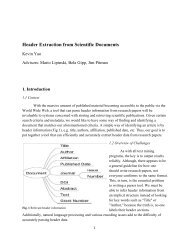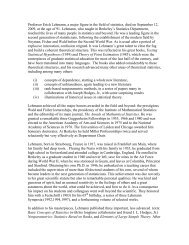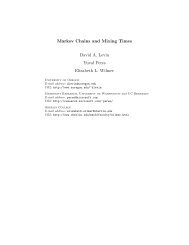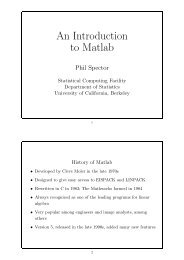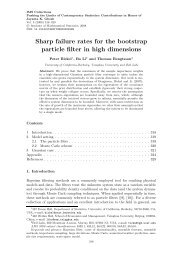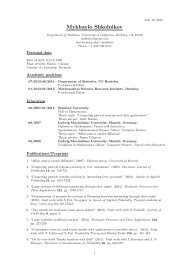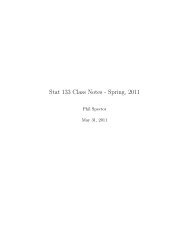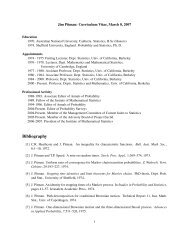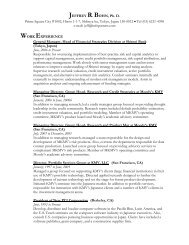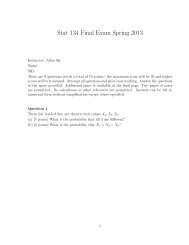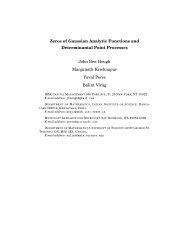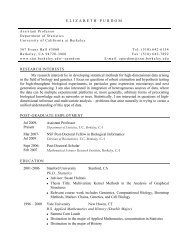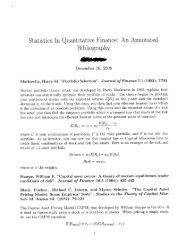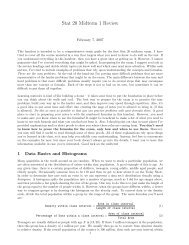The Belief in Good Luck Scale - Statistics
The Belief in Good Luck Scale - Statistics
The Belief in Good Luck Scale - Statistics
You also want an ePaper? Increase the reach of your titles
YUMPU automatically turns print PDFs into web optimized ePapers that Google loves.
JOURNAL OF RESEARCH IN PERSONALITY 31, 486–511 (1997)<br />
ARTICLE NO. RP972197<br />
<strong>The</strong> <strong>Belief</strong> <strong>in</strong> <strong>Good</strong> <strong>Luck</strong> <strong>Scale</strong><br />
Peter R. Darke<br />
Market<strong>in</strong>g Division, University of British Columbia, Vancouver, Canada<br />
and<br />
Jonathan L. Freedman<br />
University of Toronto, Toronto, Canada<br />
<strong>The</strong> construction and properties of the <strong>Belief</strong> <strong>in</strong> <strong>Good</strong> <strong>Luck</strong> (BIGL) <strong>Scale</strong> are<br />
described. Three studies provide evidence that reliable <strong>in</strong>dividual differences exist<br />
with respect to beliefs about luck. Some <strong>in</strong>dividuals ma<strong>in</strong>ta<strong>in</strong> an irrational view of<br />
luck as a somewhat stable force that tends to <strong>in</strong>fluence events <strong>in</strong> their own favor,<br />
while others seem to hold the more rational belief that luck is random and unreliable.<br />
Further, these beliefs showed a considerable amount of stability over time. <strong>The</strong><br />
BIGL was significantly related to locus of control (primarily to a chance subscale),<br />
but other evidence suggested these constructs were dist<strong>in</strong>ct. <strong>Belief</strong> <strong>in</strong> good luck was<br />
not related to general optimism, academic pessimism, self-esteem, desire for control,<br />
or achievement motivation. <strong>The</strong>re was also evidence that belief <strong>in</strong> good luck was<br />
dist<strong>in</strong>ct from feel<strong>in</strong>g fortunate or generally satisfied with one’s life. Ethnic group<br />
differences were observed for the BIGL scale, show<strong>in</strong>g that Asian-Americans were<br />
more likely to endorse superstitious beliefs about luck than non-Asians. F<strong>in</strong>ally, the<br />
BIGL scale was shown to predict positive expectations for the outcome of everyday<br />
situations that are typically associated with luck. This is generally <strong>in</strong> agreement<br />
with previous f<strong>in</strong>d<strong>in</strong>gs suggest<strong>in</strong>g that people who believe <strong>in</strong> personal good luck<br />
react to lucky events by becom<strong>in</strong>g more positive about the likelihood of future<br />
<strong>The</strong> authors are grateful to the Social Science and Humanities Research Council of Canada<br />
for its support through a postdoctoral fellowship to the first author and a research grant to the<br />
second author. We also thank the Ontario Science Centre for its cooperation. Helpful comments<br />
on previous drafts of this manuscript were provided by Professors Peter Herman and Patricia<br />
Pl<strong>in</strong>er. Thanks also to Ingrid Fedoroff, Julie Norem, and three anonymous reviewers for their<br />
suggestions concern<strong>in</strong>g this manuscript.<br />
Much of the work described here was completed as part of the first author’s doctoral dissertation<br />
<strong>in</strong> the Department of Psychology at University of Toronto. This work was a cow<strong>in</strong>ner<br />
of the 1994 J. S. Tanaka Dissertation Award <strong>in</strong> Personality Psychology.<br />
Correspondence and repr<strong>in</strong>ts requests should be addressed to Peter R. Darke, Market<strong>in</strong>g<br />
Division, Faculty of Commerce and Bus<strong>in</strong>ess Adm<strong>in</strong>istration, University of British Columbia,<br />
2053 Ma<strong>in</strong> Mall, Vancouver, BC, Canada, V6T 1Z2. E-mail: Peter.Darke@commerce.ubc.ca.<br />
486<br />
0092-6566/97 $25.00<br />
Copyright © 1997 by Academic Press<br />
All rights of reproduction <strong>in</strong> any form reserved.
BELIEF IN GOOD LUCK SCALE 487<br />
success (Darke & Freedman, 1997). In general, it is suggested that irrational beliefs<br />
about luck can serve as a source of positive expectations for the outcome of future<br />
events. © 1997 Academic Press<br />
Perceptions of luck are an important part of traditional theories concern<strong>in</strong>g<br />
the conditions typically associated with expectations for success and control<br />
(e.g., Kelley, 1967; Rotter, 1966; We<strong>in</strong>er et al., 1972). In general, these theories<br />
assume that luck is a random, uncontrollable factor which should have<br />
little effect on future expectations. Although this is certa<strong>in</strong>ly correct scientifically,<br />
many people seem to th<strong>in</strong>k of luck <strong>in</strong> a manner that is discrepant<br />
with this view. <strong>The</strong> purpose of the studies reported here was to develop a<br />
reliable measure of irrational beliefs about luck and then exam<strong>in</strong>e some of<br />
the implications these beliefs might have for expectations of success.<br />
Rotter’s social learn<strong>in</strong>g theory of personality (1955, 1966) was perhaps<br />
the first to identify factors that lead to perceptions of control. From this perspective,<br />
control should <strong>in</strong>crease when events are thought to be determ<strong>in</strong>ed<br />
primarily by an <strong>in</strong>dividual’s own actions (<strong>in</strong>ternal locus of control), but decrease<br />
if events seem to be produced by luck or other people (external locus<br />
of control). Individuals may also develop generalized expectations of control<br />
on the basis of their re<strong>in</strong>forcement history <strong>in</strong> other contexts. Perceived control<br />
could therefore be derived either directly from past experience <strong>in</strong> the<br />
same context or from more general, dispositional perceptions of one’s ability<br />
to control events. In either case, perceived control should be lower to the<br />
extent that luck was believed to be <strong>in</strong>volved.<br />
In another traditional model, We<strong>in</strong>er et al. (1972) used an attributional<br />
approach (Jones & Davis, 1965; Kelley, 1967) to expla<strong>in</strong> the orig<strong>in</strong> of perceived<br />
control. As with social learn<strong>in</strong>g theory, future expectations were<br />
thought to be based on causal explanations made for past outcomes. This<br />
model specifies four primary causal factors to which success and failure are<br />
typically attributed—ability, effort, task difficulty, and luck. <strong>The</strong>se were further<br />
categorized accord<strong>in</strong>g to both their locus of causality (as def<strong>in</strong>ed by<br />
social learn<strong>in</strong>g theory) and their stability (i.e., the degree of consistency<br />
across situations and time); with luck considered to be both external and<br />
unstable. Whereas social learn<strong>in</strong>g theory focused on the locus of causality,<br />
the attributional model suggested that stability was the key factor <strong>in</strong> determ<strong>in</strong><strong>in</strong>g<br />
perceptions of control (We<strong>in</strong>er, Nierenberg, & Goldste<strong>in</strong>, 1976).<br />
Accord<strong>in</strong>g to We<strong>in</strong>er, control should be higher when stable attributes (such<br />
as ability) are thought to be <strong>in</strong>volved <strong>in</strong> the outcome of events, but lower<br />
when unstable factors like luck seem to be responsible. Although there was<br />
some <strong>in</strong>itial support for the idea that perceived control depended primarily<br />
on the stability of the underly<strong>in</strong>g cause (We<strong>in</strong>er et al., 1976), there is good<br />
evidence that both <strong>in</strong>creased stability and <strong>in</strong>ternality lead to perceptions of<br />
control (Anderson, 1983). In any case, s<strong>in</strong>ce luck was specified as the unsta-
488 DARKE AND FREEDMAN<br />
ble and external causal attribute, We<strong>in</strong>er’s model also predicted that any past<br />
success due to luck should be viewed as uncontrollable, with no implications<br />
for future success.<br />
Thus, the traditional notion has been that events which are thought to be<br />
determ<strong>in</strong>ed by luck should necessarily be perceived as uncontrollable. This<br />
is largely because these theories implicitly assume that most, if not all, people<br />
hold rational beliefs about the causal properties of luck. Chance events are<br />
<strong>in</strong>dependent of one another accord<strong>in</strong>g to the rational view, which means that<br />
future events cannot be predicted on the basis of past luck and that one person<br />
is as likely to be lucky as another. However, it seemed to us that some people<br />
‘‘believe <strong>in</strong> luck,’’ mean<strong>in</strong>g that they th<strong>in</strong>k good luck consistently produces<br />
success <strong>in</strong> their daily lives. People sometimes say they have lucky days or<br />
that they th<strong>in</strong>k of themselves as lucky people <strong>in</strong> general. <strong>The</strong>se k<strong>in</strong>ds of<br />
statements seem to imply that luck is viewed as a personal quality that is at<br />
least somewhat stable over time. In other words, rather than ma<strong>in</strong>ta<strong>in</strong><strong>in</strong>g the<br />
rational view that luck is external and unstable, at least some people talk<br />
about good luck as though it were just the opposite—personal and stable.<br />
In this sense, they seem to ma<strong>in</strong>ta<strong>in</strong> irrational or superstitious beliefs about<br />
luck.<br />
One possible implication of th<strong>in</strong>k<strong>in</strong>g about luck as personal and stable is<br />
that such beliefs might serve as a source of perceived control <strong>in</strong> certa<strong>in</strong> situations.<br />
In fact, this idea follows readily from the general pr<strong>in</strong>ciples underly<strong>in</strong>g<br />
the traditional view. Although we doubted that all people viewed luck as<br />
external/unstable, we did accept the more general notion that <strong>in</strong>ternal/stable<br />
factors tend to be perceived as controllable (as suggested by both theory and<br />
empirical evidence). If so, people who believe they are consistently lucky<br />
may also th<strong>in</strong>k that their luck provides some amount of control, <strong>in</strong> much the<br />
same way that other <strong>in</strong>ternal/stable attributes lead to perceptions of control. 1<br />
Thus, from the perspective of someone who believes <strong>in</strong> luck, past luck might<br />
be expected to lead to positive expectations for success <strong>in</strong> the future. <strong>The</strong>se<br />
<strong>in</strong>dividuals would presumably th<strong>in</strong>k their past luck should cont<strong>in</strong>ue, just as<br />
people who view past success as due to their personal skill (an <strong>in</strong>ternal/<br />
stable causal factor) should anticipate future success.<br />
Indeed, attempt<strong>in</strong>g to control luck is presumably the purpose of many<br />
common rituals and superstitions. Even those who consider themselves extremely<br />
rational and scientific may sometimes knock on wood to avoid bad<br />
luck or carry an object such as a rabbit’s foot for good luck. <strong>The</strong> rituals<br />
exhibited by gamblers (e.g., blow<strong>in</strong>g on dice before throw<strong>in</strong>g them) seem<br />
<strong>in</strong>dicative of similar beliefs (Hensl<strong>in</strong>, 1967; Langer, 1977). Furthermore, ath-<br />
1 We use the terms perceived control, expectancy, predictability, and confidence <strong>in</strong>terchangeably.<br />
This is <strong>in</strong> keep<strong>in</strong>g with common usage <strong>in</strong> the previous literature (e.g., Langer,<br />
1975; Rotter, 1955, 1966; We<strong>in</strong>er, 1986).
BELIEF IN GOOD LUCK SCALE 489<br />
letes often engage <strong>in</strong> superstitious behavior, such as wear<strong>in</strong>g the same<br />
‘‘gameshirt’’ dur<strong>in</strong>g a w<strong>in</strong>n<strong>in</strong>g streak to help ensure cont<strong>in</strong>ued success. It<br />
is as though these rituals provide some means of exercis<strong>in</strong>g or activat<strong>in</strong>g<br />
personal luck <strong>in</strong> order to achieve success.<br />
In fact, Langer (1975) found that <strong>in</strong>dividuals sometimes developed an illusion<br />
of control over outcomes that were determ<strong>in</strong>ed entirely by chance. In<br />
a series of experiments, she showed that confidence <strong>in</strong>creased when tasks<br />
<strong>in</strong>cluded features that were likely to improve performance had there been<br />
skill <strong>in</strong>volved. For <strong>in</strong>stance, participants who were given the opportunity to<br />
practice a chance-determ<strong>in</strong>ed task were more confident than those who received<br />
no practice at all. Practice might reasonably be expected to improve<br />
performance when skill is <strong>in</strong>volved, but this expectation is obviously irrational<br />
when outcomes are determ<strong>in</strong>ed entirely by chance. Although these studies<br />
did not directly exam<strong>in</strong>e irrational beliefs about luck, they do at least<br />
provide evidence that people sometimes act as if they can control chance<br />
(see Darke & Freedman, 1997, for further discussion).<br />
Generally speak<strong>in</strong>g, irrational beliefs about luck may provide an important<br />
means of cop<strong>in</strong>g with the very real <strong>in</strong>fluence that chance sometimes has on<br />
everyday life. <strong>The</strong>re are undoubtedly events such as accidents and natural<br />
disasters that are largely beyond any direct attempts to control. <strong>The</strong> uncerta<strong>in</strong>ty<br />
associated with the possibility that such events may occur can be quite<br />
disconcert<strong>in</strong>g, especially when the consequences are substantial. Rothbaum,<br />
Weisz, and Snyder (1982) suggest that irrational beliefs about luck may<br />
allow <strong>in</strong>dividuals to rema<strong>in</strong> optimistic even when it is objectively impossible<br />
to exercise direct control over one’s circumstances. In their words, people<br />
‘‘. . . attempt to associate themselves with chance so as to share <strong>in</strong> the power<br />
of this larger force . . . seem<strong>in</strong>gly regard<strong>in</strong>g luck as a type of control’’ (Rothbaum<br />
et al., 1982, p. 11). In particular, they suggest that people are likely<br />
to rely on irrational beliefs about luck as a source of optimism when it is<br />
difficult or impossible to control events through direct action. People often do<br />
<strong>in</strong> fact become more superstitious when exposed to seem<strong>in</strong>gly uncontrollable<br />
threats to their personal well-be<strong>in</strong>g. In a study conducted dur<strong>in</strong>g the Gulf<br />
War, Israelis who lived <strong>in</strong> cities that were under missile attack were more<br />
likely to endorse magical or superstitious ideas than those who lived <strong>in</strong> cities<br />
that were not under attack (Ke<strong>in</strong>an, 1994). Many of the superstitious thoughts<br />
exam<strong>in</strong>ed <strong>in</strong> this study were related to the idea that luck could be controlled.<br />
Thus, there is a considerable amount of anecdotal evidence, theoretical<br />
speculation, and even some <strong>in</strong>direct empirical support for the idea that at<br />
least some people hold irrational or superstitious beliefs about luck. However,<br />
little work has attempted to measure these beliefs directly or to <strong>in</strong>vestigate<br />
their role <strong>in</strong> determ<strong>in</strong><strong>in</strong>g perceptions of control. <strong>The</strong> present studies<br />
were designed to construct a reliable measure of <strong>in</strong>dividual differences <strong>in</strong><br />
people’s beliefs about luck. Three <strong>in</strong>itial measurement studies were con-
490 DARKE AND FREEDMAN<br />
ducted <strong>in</strong> the process of develop<strong>in</strong>g what we have called the <strong>Belief</strong> <strong>in</strong> <strong>Good</strong><br />
<strong>Luck</strong> (BIGL) <strong>Scale</strong>. In Study 1, we began by def<strong>in</strong><strong>in</strong>g what we thought were<br />
the important characteristics of beliefs about luck and then created an <strong>in</strong>itial<br />
set of items to account for different aspects of this def<strong>in</strong>ition. Studies 2 and<br />
3 further <strong>in</strong>vestigated the reliability and generalizability of the BIGL measure.<br />
This measure was also compared to other personality characteristics<br />
that seemed potentially related, <strong>in</strong> order to establish convergent and discrim<strong>in</strong>ant<br />
validity (see Study 1 for further discussion). F<strong>in</strong>ally, a fourth set of<br />
studies <strong>in</strong>vestigated whether participants were able to make a dist<strong>in</strong>ction between<br />
beliefs <strong>in</strong> personal luck and the somewhat different view that one has<br />
had a fortunate or satisfy<strong>in</strong>g life.<br />
Ethnic group differences <strong>in</strong> the BIGL were also exam<strong>in</strong>ed. <strong>The</strong>re have<br />
been numerous suggestions that members of Eastern cultures are more likely<br />
to th<strong>in</strong>k of personal luck as a source of security and optimism <strong>in</strong> their daily<br />
lives (e.g., Church, 1987; Weisz, Rothbaum, & Blackburn, 1984). With this<br />
<strong>in</strong> m<strong>in</strong>d, we predicted that people with an Asian-American background might<br />
be more likely to endorse a belief <strong>in</strong> good luck than non-Asians. If so, this<br />
would provide some <strong>in</strong>dication of the predictive validity of the BIGL scale.<br />
F<strong>in</strong>ally, the validity of the BIGL was considered more directly. Our strategy<br />
was to exam<strong>in</strong>e whether believ<strong>in</strong>g that luck was personal and stable (as<br />
measured by the BIGL scale) was associated with <strong>in</strong>creased perceptions of<br />
control <strong>in</strong> some circumstances. This provided the clearest means of validat<strong>in</strong>g<br />
the BIGL, s<strong>in</strong>ce it would help establish the crucial l<strong>in</strong>k between the belief<br />
that luck is <strong>in</strong>ternal and stable, and the theoretical prediction that such beliefs<br />
should lead to perceptions of control when luck is an important factor <strong>in</strong><br />
determ<strong>in</strong><strong>in</strong>g events.<br />
DERIVATION OF THE BELIEF IN GOOD LUCK SCALE<br />
(STUDIES 1, 2, AND 3)<br />
<strong>Belief</strong> <strong>in</strong> good luck was def<strong>in</strong>ed as the view that luck is a somewhat stable<br />
characteristic that consistently favors some people but not others and is especially<br />
likely to favor oneself. In contrast, disbelief <strong>in</strong> luck was def<strong>in</strong>ed as<br />
the tendency to agree with the rational view of luck as random and unreliable.<br />
Studies by Wagenaar (Wagenaar & Keren, 1988; Wagenaar, Keren, & Pleit-<br />
Kuiper, 1984) support the idea that people make dist<strong>in</strong>ctions between luck<br />
and chance when describ<strong>in</strong>g gambl<strong>in</strong>g outcomes. For <strong>in</strong>stance, gamblers use<br />
the word luck to refer to apparent ‘‘streaks’’ or ‘‘runs’’ <strong>in</strong> gambl<strong>in</strong>g outcomes,<br />
while chance is used to refer to the lack of any discernable pattern<br />
for random events. Our def<strong>in</strong>ition focused primarily on perceptions concern<strong>in</strong>g<br />
the locus and stability of luck, s<strong>in</strong>ce these dimensions were the most<br />
mean<strong>in</strong>gful theoretically speak<strong>in</strong>g. A number of <strong>in</strong>itial items were constructed<br />
to account for various aspects of the belief <strong>in</strong> good luck <strong>in</strong> Study<br />
1. Note that perceptions concern<strong>in</strong>g the controllability of luck were not ex-
BELIEF IN GOOD LUCK SCALE 491<br />
plicitly <strong>in</strong>cluded as items <strong>in</strong> the BIGL scale itself. Instead, this was left to<br />
empirical verification <strong>in</strong> subsequent studies that exam<strong>in</strong>ed the validity of the<br />
scale (as discussed above).<br />
Although we suspected that not believ<strong>in</strong>g <strong>in</strong> good luck meant luck was<br />
thought to be random, an alternative possibility was that this might actually<br />
imply a belief <strong>in</strong> personal bad luck (i.e., one’s luck is usually bad). Items<br />
designed to capture both mean<strong>in</strong>gs were therefore <strong>in</strong>cluded <strong>in</strong> Study 1, so<br />
that we could exam<strong>in</strong>e each of these possibilities. Some items suggested that<br />
luck could not have any reliable effects (e.g., ‘‘<strong>Luck</strong> is noth<strong>in</strong>g more than<br />
random chance.’’), while others dealt with the idea that people might th<strong>in</strong>k<br />
they were unlucky (e.g., ‘‘I consider myself to be an unlucky person.’’). In<br />
order to further dist<strong>in</strong>guish the BIGL and beliefs <strong>in</strong> bad luck, comparisons<br />
were also made with other <strong>in</strong>dividual differences <strong>in</strong>cluded <strong>in</strong> Study 1. F<strong>in</strong>ally,<br />
<strong>in</strong> order to estimate the relative frequency of people who believed they<br />
were unlucky, we <strong>in</strong>cluded a separate rat<strong>in</strong>g that allowed people to categorize<br />
themselves as either unlucky, lucky, or neither lucky nor unlucky. It was<br />
suspected that only a small m<strong>in</strong>ority of respondents would actually believe<br />
they were unlucky.<br />
Individual difference measures that seemed potentially related to the BIGL<br />
scale were also <strong>in</strong>cluded <strong>in</strong> Studies 1 and 2. Locus of control was used to<br />
exam<strong>in</strong>e the convergent validity of the scale. <strong>The</strong> BIGL was expected to be<br />
positively related to external perceptions of control, s<strong>in</strong>ce th<strong>in</strong>k<strong>in</strong>g of luck<br />
as a prevalent <strong>in</strong>fluence <strong>in</strong> daily life is common to both constructs (see also<br />
Rotter, 1966). Measures of optimism and self-esteem were <strong>in</strong>cluded to assess<br />
the discrim<strong>in</strong>ant validity of the BIGL scale. It seemed possible that the belief<br />
<strong>in</strong> good luck might simply be part of a more general optimistic outlook (i.e.,<br />
the belief that th<strong>in</strong>gs tend to work out well for oneself, for whatever reason).<br />
If so, people who say they are personally lucky might just th<strong>in</strong>k that everyth<strong>in</strong>g<br />
tends to go their way, whether luck is <strong>in</strong>volved or not. A slightly different<br />
possibility was that believ<strong>in</strong>g <strong>in</strong> personal good luck might be a specific<br />
form of a general tendency to th<strong>in</strong>k highly of oneself. That is, perhaps <strong>in</strong>dividuals<br />
who say they are lucky are high <strong>in</strong> self-esteem. Despite such possibilities,<br />
it was predicted that belief <strong>in</strong> good luck was dist<strong>in</strong>ct from these personality<br />
traits.<br />
Measures of desire for control and achievement motivation were completed<br />
by subjects <strong>in</strong> Study 1 to exam<strong>in</strong>e whether irrational beliefs about<br />
luck might arise from these motivational concerns. A number of studies have<br />
shown that people with a strong desire to control important events sometimes<br />
act as if they can <strong>in</strong>fluence chance (Burger, 1986; Burger & Cooper, 1979).<br />
In addition, it seemed possible that beliefs <strong>in</strong> good luck might be motivated<br />
by a desire to achieve success. For <strong>in</strong>stance, people who believe <strong>in</strong> good<br />
luck might th<strong>in</strong>k that this gives them the advantage they need to do well or<br />
get ahead <strong>in</strong> life. <strong>The</strong>se ideas were also exam<strong>in</strong>ed <strong>in</strong> Study 1.
492 DARKE AND FREEDMAN<br />
Participants<br />
METHODS<br />
<strong>The</strong> participants <strong>in</strong> Study 1 were 231 visitors to the Ontario Science Centre <strong>in</strong> Toronto,<br />
Canada (114 men, 110 women, and 7 miss<strong>in</strong>g responses). Ages ranged from 16 to 69 years<br />
(M 34 years). Participants <strong>in</strong> Studies 2 and 3 were Introductory Psychology students who<br />
had volunteered to complete a test battery at the beg<strong>in</strong>n<strong>in</strong>g of the school year. Study 2 was<br />
conducted at the University of Toronto, Canada (N 1453), while the third study was completed<br />
at New York University (N 494). <strong>The</strong> ratio of females to males <strong>in</strong> the university<br />
samples was approximately 2 to 1.<br />
<strong>Belief</strong> <strong>in</strong> <strong>Good</strong> <strong>Luck</strong> Items<br />
We <strong>in</strong>itially constructed 14 items that seemed to capture the essence of a belief <strong>in</strong> good<br />
luck accord<strong>in</strong>g to our def<strong>in</strong>ition (see Table 1). <strong>The</strong> first study also <strong>in</strong>cluded a bad luck item<br />
(labeled m <strong>in</strong> Table 1). In Studies 1 and 3, participants <strong>in</strong>dicated the extent of their agreement<br />
us<strong>in</strong>g a Likert-type scale labeled: strongly disagree (1), somewhat disagree (2), slightly disagree<br />
(3), slightly agree (4), somewhat agree (5), and strongly agree (6). Study 2 used a similar<br />
four po<strong>in</strong>t agree–disagree scale. Only those items that had loaded substantially onto the BIGL<br />
dimension <strong>in</strong> the first study were <strong>in</strong>cluded <strong>in</strong> Studies 2 and 3.<br />
Additional Measures Included <strong>in</strong> Studies 1 and 2<br />
Locus of control (LOC). Measured by Levenson’s (1981) 24 item scale. This assesses the<br />
extent to which events are generally thought to be determ<strong>in</strong>ed by factors such as luck and<br />
powerful others versus <strong>in</strong>ternal factors, such as skill and effort. This measure also provided<br />
separate subscale scores for <strong>in</strong>ternal, chance, and powerful other doma<strong>in</strong>s of control. <strong>The</strong><br />
BIGL was most likely to be related to the chance doma<strong>in</strong> of external control, while the belief<br />
that other people control events seemed only remotely related. It was less clear how the BIGL<br />
would be correlated with the <strong>in</strong>ternal subscale.<br />
Optimism. <strong>The</strong> Life Orientation Test (LOT; Scheier & Carver, 1985) was used to measure<br />
optimism <strong>in</strong> Study 1. <strong>The</strong> LOT <strong>in</strong>cludes eight target items (e.g., ‘‘I’m always optimistic about<br />
the future’’), plus four fillers. In Study 2, the Defensive Pessimism Questionnaire (DPQ;<br />
Norem & Cantor, 1986; Norem & Ill<strong>in</strong>gworth, 1993) was used. This scale is composed of<br />
n<strong>in</strong>e items concerned with whether people typically focus on the negative consequences of<br />
failure <strong>in</strong> academic situations (e.g., ‘‘I often th<strong>in</strong>k about what it would be like if I do very<br />
poorly <strong>in</strong> an academic situation.’’) versus positive consequences (e.g., ‘‘I often try to figure<br />
out how likely it is that I will do very well <strong>in</strong> an academic situation.’’). Each item was rated<br />
from 1 (not at all) to 5 (very much). Responses were scored and summed so that higher values<br />
would <strong>in</strong>dicate greater defensive pessimism (i.e., less optimism).<br />
Self-esteem (SE). Rosenberg’s (1965) measure of global self-esteem was completed by<br />
subjects <strong>in</strong> Studies 1 and 2 <strong>in</strong> order to exam<strong>in</strong>e whether the BIGL was dist<strong>in</strong>ct from a general<br />
sense of positive self regard.<br />
Desire for control (DC). Study 1 also <strong>in</strong>cluded the desire for control scale (Burger &<br />
Cooper, 1979) to exam<strong>in</strong>e whether beliefs <strong>in</strong> personal good luck were motivated <strong>in</strong> part by<br />
a desire for control. An example item from this measure is, ‘‘I enjoy hav<strong>in</strong>g control over my<br />
own dest<strong>in</strong>y.’’<br />
Achievement motivation (Ach). <strong>The</strong> 19 items of the Work and Family Orientation <strong>Scale</strong><br />
(Spence & Helmreich, 1983) were used to assess achievement motives <strong>in</strong> Study 1, and exam<strong>in</strong>e<br />
whether such motives were related to beliefs <strong>in</strong> good luck.<br />
Due to restrictions on the amount of time participants were available <strong>in</strong> Study 1, it was not<br />
possible to have everyone complete all of the additional <strong>in</strong>dividual difference measures. In-
BELIEF IN GOOD LUCK SCALE 493<br />
stead, all participants completed the BIGL, LOC, and LOT scales, but were randomly assigned<br />
to complete only one of the SE (n 76), DC (n 75), or Ach (n 80) measures. All subjects<br />
<strong>in</strong> Study 2 were asked to complete the BIGL, DPQ, and SE scales.<br />
Overall personal luck. After complet<strong>in</strong>g the <strong>in</strong>dividual BIGL items, participants <strong>in</strong> the<br />
first study were also asked to summarize their perceptions of luck us<strong>in</strong>g an overall rat<strong>in</strong>g.<br />
Specifically, subjects <strong>in</strong>dicated whether they considered themselves to be: (1) a very unlucky<br />
person, (2) a somewhat unlucky person, (3) neither a lucky nor unlucky person, (4) a somewhat<br />
lucky person, or (5) a very lucky person. <strong>The</strong> overall rat<strong>in</strong>g was used to determ<strong>in</strong>e the relative<br />
proportion of people who believed they were unlucky. It was also possible to exam<strong>in</strong>e which<br />
of these overall groups the BIGL scale was able to differentiate among. S<strong>in</strong>ce the scale was<br />
constructed to exam<strong>in</strong>e differences <strong>in</strong> the extent to which good luck was stable/personal versus<br />
random, it was predicted that people who categorize themselves as neither lucky nor unlucky<br />
would score lower on the BIGL than those who believe they are typically unlucky, who <strong>in</strong><br />
turn should score lower than people who categorize themselves as typically lucky <strong>in</strong>dividuals. 2<br />
Test–Retest Reliability (Study 3)<br />
<strong>The</strong> stability of responses on the BIGL measure was also exam<strong>in</strong>ed as part of the third<br />
study. One-hundred-eleven of the students who had <strong>in</strong>itially completed the BIGL items (59<br />
women; 52 men) were asked to complete the scale a second time 1 to 2 months after the first<br />
assessment. This second adm<strong>in</strong>istration was conducted follow<strong>in</strong>g participation <strong>in</strong> an unrelated<br />
experiment.<br />
RESULTS AND DISCUSSION<br />
Factor Analysis of BIGL Items<br />
<strong>The</strong> correlation matrix for the responses to the luck items <strong>in</strong> each of the<br />
studies was computed and submitted to a pr<strong>in</strong>ciple axes factor analysis to<br />
exam<strong>in</strong>e their dimensionality. Cattell’s (1966) scree test suggested a s<strong>in</strong>gle<br />
factor solution <strong>in</strong> each case. 3 <strong>The</strong> eigenvalues associated with the first factor<br />
<strong>in</strong> each sample were: λ1 5.03, λ2 3.79, and λ3 4.68. Factor load<strong>in</strong>gs<br />
are shown <strong>in</strong> Table 1 (along with item means and standard deviations). In<br />
2 It seemed to us that those who believed they were unlucky might actually agree with some<br />
of the more general BIGL items (e.g., Some people are consistently lucky, and others are<br />
unlucky) and only disagree with the items that specifically suggest their personal luck is good<br />
(e.g., I consistently have good luck). In comparison, those who suggest they are neither lucky<br />
nor unlucky would presumably disagree with both types of items, while those who th<strong>in</strong>k they<br />
are personally lucky should be more likely to agree with both personal and general beliefs <strong>in</strong><br />
good luck.<br />
3 It is also possible to derive a multiple factor solution of the BIGL items us<strong>in</strong>g Kaiser’s<br />
(1960) criterion. <strong>The</strong>se analyses reliably <strong>in</strong>dicate that the BIGL has three subscales that are<br />
significantly <strong>in</strong>tercorrelated: Personal belief <strong>in</strong> luck (items c, e, g, and j), General belief <strong>in</strong><br />
luck (items a, b, d, and n), and Chance/Distrust (items i, k, l, and o). <strong>The</strong> s<strong>in</strong>gle bad luck<br />
item loaded (.69) onto a separate and uncorrelated factor <strong>in</strong> Study 1. See Darke (1993) for a<br />
full description.<br />
Both the multiple and s<strong>in</strong>gle factor solutions were considered when determ<strong>in</strong><strong>in</strong>g which items<br />
were reta<strong>in</strong>ed for the BIGL scale. <strong>The</strong> s<strong>in</strong>gle factor solution is presented here ma<strong>in</strong>ly for<br />
reasons of parsimony, and because the results of subsequent experiments employ<strong>in</strong>g the BIGL<br />
did not depend substantially on whether total scores or subscale scores were used.
494 DARKE AND FREEDMAN<br />
TABLE 1<br />
Descriptive <strong>Statistics</strong> and Factor Load<strong>in</strong>gs for <strong>Belief</strong> <strong>in</strong> <strong>Good</strong> <strong>Luck</strong> Items<br />
<strong>in</strong> Studies 1, 2, and 3<br />
Study<br />
Item 1 2 3<br />
a) <strong>Luck</strong> plays an important part <strong>in</strong> everyone’s life. .67 .52 .66<br />
4.13 2.46 4.07<br />
b) Some people are consistently lucky, and others are<br />
1.43 .97 1.36<br />
unlucky. .61 .47 .53<br />
3.89 2.60 3.74<br />
1.57 .88 1.38<br />
c) I consider myself to be a lucky person. .69 .50 .60<br />
3.89 2.80 3.83<br />
1.33 .85 1.33<br />
d) I believe <strong>in</strong> luck. .73 .61 .70<br />
4.01 2.57 4.01<br />
1.48 .92 1.46<br />
e) I often feel like it’s my lucky day. .62 .52 .62<br />
3.52 2.18 3.17<br />
1.43 .86 1.42<br />
f) Nobody can w<strong>in</strong> at games of chance <strong>in</strong> the long-run. .21 na na<br />
4.00 na na<br />
1.72 na na<br />
g) I consistently have good luck. .61 .55 .69<br />
3.13 2.22 2.91<br />
1.29 .84 1.27<br />
h) I tend to w<strong>in</strong> games of chance. .40 na na<br />
2.88 na na<br />
1.37 na na<br />
i) It’s a mistake to base any decisions on how lucky<br />
you feel. a .25 .20 .28<br />
4.34 3.23 4.43<br />
1.53 1.05 1.54<br />
j) <strong>Luck</strong> works <strong>in</strong> my favor. .67 .65 .71<br />
3.15 2.36 3.19<br />
1.29 .83 1.24<br />
k) I don’t m<strong>in</strong>d leav<strong>in</strong>g th<strong>in</strong>gs to chance because I’m a<br />
lucky person. .49 .47 .50<br />
2.39 1.54 2.13<br />
1.39 .74 1.16<br />
l) Even the th<strong>in</strong>gs <strong>in</strong> life I can’t control tend to go my<br />
way because I’m lucky. .61 .65 .65<br />
2.59 1.90 2.48<br />
1.34 .80 1.27
BELIEF IN GOOD LUCK SCALE 495<br />
TABLE 1—Cont<strong>in</strong>ued<br />
Study<br />
Item 1 2 3<br />
m) I consider myself to be an unlucky person. .05 na na<br />
2.60 na na<br />
n) <strong>The</strong>re is such a th<strong>in</strong>g as luck that favors some<br />
1.38 na na<br />
people, but not others. .58 .46 .50<br />
3.23 2.33 3.18<br />
1.48 .97 1.51<br />
o) <strong>Luck</strong> is noth<strong>in</strong>g more than random chance. a .38 .30 .42<br />
4.27 3.21 4.41<br />
1.56 .99 1.44<br />
Rat<strong>in</strong>g scale 1–6 1–4 1–6<br />
Cronbach’s alpha .85 .78 .85<br />
Eigenvalue 5.03 3.79 4.68<br />
M(Total) 39.33 26.52 37.87<br />
SD(Total) 10.63 5.86 10.05<br />
N 231 1453 494<br />
Note. Item factor load<strong>in</strong>gs are shown <strong>in</strong> bold, item means are italicized, and item standard<br />
deviations appear <strong>in</strong> pla<strong>in</strong> text. na, not available due to elim<strong>in</strong>ation of item after Study 1.<br />
a Item reverse scored.<br />
general, items that described luck as a personal or consistent quality loaded<br />
positively, whereas those items suggest<strong>in</strong>g luck was unreliable and constituted<br />
noth<strong>in</strong>g more than chance tended to load negatively onto the same<br />
dimension. Factor load<strong>in</strong>gs were also very consistent for the three studies.<br />
It is important to note that the item that was concerned with a belief <strong>in</strong><br />
personal bad luck (item m) was unrelated to the BIGL factor <strong>in</strong> Study 1.<br />
This suggests that beliefs about personal good luck and bad luck are largely<br />
<strong>in</strong>dependent. Thus, people who tend to disagree with BIGL items do not<br />
seem to mean they th<strong>in</strong>k they are unlucky people. Rather, the BIGL items<br />
seem to dist<strong>in</strong>guish between the belief that good luck is a personal and consistent<br />
factor versus the idea that luck is random.<br />
<strong>The</strong> BIGL scale was created on the basis of the factor analysis <strong>in</strong> Study<br />
1. Items that had a factor load<strong>in</strong>g with an absolute value of .25 or greater<br />
were <strong>in</strong>cluded <strong>in</strong> the measure (with the exception of item h, which was<br />
dropped despite meet<strong>in</strong>g this criterion). Twelve of the orig<strong>in</strong>al items were<br />
selected for <strong>in</strong>clusion <strong>in</strong>to the scale on this basis (items a, b, c, d, e, g, i, j,<br />
k, l, n, and o). Total BIGL scores were computed by summ<strong>in</strong>g the selected<br />
items, after reverse scor<strong>in</strong>g items i and o. Descriptive statistics for these totals<br />
are shown at the bottom of Table 1. <strong>The</strong> estimate of <strong>in</strong>ternal consistency was
496 DARKE AND FREEDMAN<br />
similar for each of the samples: α 0.85 <strong>in</strong> Studies 1 and 3, and α 0.78<br />
<strong>in</strong> Study 2.<br />
Males and females were compared <strong>in</strong> terms of their total BIGL scores for<br />
each sample, but there were no significant sex differences. Total BIGL scores<br />
were also unrelated to participant age <strong>in</strong> Study 1.<br />
Test–Retest Reliability (Study 3)<br />
As mentioned, a subset of the respondents who had completed the orig<strong>in</strong>al<br />
adm<strong>in</strong>istration of the BIGL <strong>in</strong> Study 3 also completed the scale for a second<br />
time a number of weeks later. <strong>The</strong> correlation computed between total BIGL<br />
scores for the two adm<strong>in</strong>istrations was r(110) .63, p .001, suggest<strong>in</strong>g<br />
that beliefs <strong>in</strong> good luck are quite stable over time.<br />
Convergent and Discrim<strong>in</strong>ant Validity: Additional Measures Included <strong>in</strong><br />
Studies 1 and 2<br />
Total scores of the BIGL were compared with the other <strong>in</strong>dividual difference<br />
measures <strong>in</strong>cluded <strong>in</strong> Study 1. <strong>The</strong>se are shown <strong>in</strong> Table 2. Look<strong>in</strong>g<br />
at the first row, the predicted correlation between the BIGL and total locus<br />
control scores was significant. Correlations with the external subscales of<br />
the LOC measure showed that only the chance subscale was substantially<br />
correlated with BIGL total scores, while the magnitude of the correlation<br />
with the powerful others subscale was quite small. F<strong>in</strong>ally, the <strong>in</strong>ternal subscale<br />
scores were not significantly related to beliefs <strong>in</strong> luck. Thus, the observed<br />
association between BIGL and LOC total scores seemed ma<strong>in</strong>ly attributable<br />
to the chance subscale. Overall, these f<strong>in</strong>d<strong>in</strong>gs imply that those<br />
who believed <strong>in</strong> good luck specifically thought that luck had an important<br />
impact on their lives, rather than hav<strong>in</strong>g an external locus of control <strong>in</strong> general.<br />
At the same time, believers and nonbelievers seemed just as likely to<br />
th<strong>in</strong>k that skill and other personal qualities exert an important <strong>in</strong>fluence over<br />
everyday events.<br />
It can also be seen that the BIGL did not correlate significantly with optimism<br />
(measured by the LOT scale) or self-esteem. <strong>The</strong> results of the second<br />
study confirmed there was no correlation between the BIGL measure and<br />
optimism (measured us<strong>in</strong>g the DPQ) or self-esteem; r(1406) .04 and<br />
r(1312) .02. 4 <strong>The</strong>refore, as predicted, beliefs <strong>in</strong> good luck seemed to be<br />
dist<strong>in</strong>ct from general optimism or simply hav<strong>in</strong>g a positive view of oneself.<br />
<strong>The</strong> BIGL was not significantly correlated with either the DC or Ach measures.<br />
Thus, there was little evidence that beliefs about luck were related to<br />
achievement motives or a desire for control. This seemed somewhat surpris<strong>in</strong>g,<br />
and we suggest that it might be worth exam<strong>in</strong><strong>in</strong>g this question further<br />
4 <strong>The</strong> DPQ can also be exam<strong>in</strong>ed as separate optimism and pessimism subscales (Norem &<br />
Ill<strong>in</strong>gworth, 1993). <strong>The</strong> correlations of these subscales with the BIGL were similar to the<br />
overall DPQ measure; r(1413) .09 and r(1416) .03, for optimism and pessimism.
TABLE 2<br />
Correlations of the BIGL, LOT, LOC, and Personal Bad <strong>Luck</strong> with the Other Individual Difference Measures Included <strong>in</strong> Study 1<br />
DC SE Ach LOT LOC LOCInt LOCCh LOCPO<br />
BELIEF IN GOOD LUCK SCALE 497<br />
BIGL .12 .20 .02 .01 .34*** .08 .43*** .18**<br />
LOC .08 .53*** .16 .45*** — .58*** .86*** .85***<br />
LOCInt .03 .50*** .20 .35*** — — — —<br />
LOCCh .09 .33** .16 .34*** — — — —<br />
LOCPO .12 .40*** .08 .38*** — — — —<br />
LOT .24 .45*** .22 — — — — —<br />
Unlucky .01 .29** .16 .36*** .29*** .14* .31*** .22**<br />
N 57–62 66–73 59–67 191–210 194–202 202–216 202–214 202–211<br />
Note. BIGL, total scores for belief <strong>in</strong> good luck scale; DC, desire for control; SE, self-esteem; Ach, achievement motivation; LOT, optimism<br />
(higher scores signify more of each attribute). LOC, LOCInt, LOCCh, and LOCPO are totals for the complete locus of control measure, <strong>in</strong>ternal,<br />
chance, and powerful others subscales. Higher scores <strong>in</strong>dicate greater <strong>in</strong>ternality for the total scale and <strong>in</strong>creased perceptions that control lies <strong>in</strong><br />
the relevant doma<strong>in</strong> for subscales. <strong>The</strong> unlucky row <strong>in</strong>cludes correlations for the s<strong>in</strong>gle item that asked whether subjects typically thought of<br />
themselves as unlucky people. Dashes <strong>in</strong>dicate either that the correlation was not of particular <strong>in</strong>terest or that it is already reported elsewhere <strong>in</strong><br />
the table.<br />
* p .05, ** p .01, and *** p .001; two tailed.
498 DARKE AND FREEDMAN<br />
before draw<strong>in</strong>g any firm conclusions concern<strong>in</strong>g the role of motivation.<br />
In spite of the observed similarity between luck beliefs and locus of control,<br />
Table 2 also shows evidence that these are dist<strong>in</strong>ct constructs. In particular,<br />
LOC total scores and each of the subscales were significantly correlated<br />
with both optimism and self-esteem, but (as noted) BIGL was not associated<br />
with either of these other measures. In general, it seems that the BIGL and<br />
LOC are somewhat related, but separate constructs.<br />
Dist<strong>in</strong>ctions between the BIGL and Bad <strong>Luck</strong> (Study 1)<br />
As mentioned, the <strong>in</strong>itial factor analysis suggested that believ<strong>in</strong>g <strong>in</strong> personal<br />
bad luck was unrelated to the belief <strong>in</strong> good luck construct. In keep<strong>in</strong>g<br />
with the results of that analysis, the correlation between total BIGL scores<br />
and the unlucky item was nonsignificant, r(214) .05. To exam<strong>in</strong>e these<br />
dist<strong>in</strong>ctions further, the item that assessed bad luck was correlated with the<br />
other <strong>in</strong>dividual differences <strong>in</strong>cluded <strong>in</strong> Study 1 (see bottom row <strong>in</strong> Table<br />
2). As with the BIGL scale, beliefs <strong>in</strong> bad luck were related to LOC total<br />
scores. However, unlike total BIGL scores, personal bad luck was associated<br />
with lower optimism and self-esteem. 5 <strong>The</strong>se f<strong>in</strong>d<strong>in</strong>gs further establish that<br />
the BIGL scale is dist<strong>in</strong>ct from beliefs about personal bad luck.<br />
Subjects <strong>in</strong> Study 1 were also classified <strong>in</strong>to one of three groups on the<br />
basis of the f<strong>in</strong>al overall personal luck categorization they made: unlucky,<br />
neither, or lucky. Of the subjects who completed this measure (N 215),<br />
the proportion of those who considered themselves lucky (51.63%) was similar<br />
to the proportion who thought they were neither lucky nor unlucky<br />
(43.72%), while very few subjects said they were unlucky (4.65%). Next,<br />
these three groups were exam<strong>in</strong>ed <strong>in</strong> terms of their BIGL scores by comput<strong>in</strong>g<br />
a one-way analysis of variance. Not surpris<strong>in</strong>gly, there was a significant<br />
overall effect, F(2, 212) 23.93, p .0001. However, more importantly,<br />
posthoc tests (Fisher, 1949) showed that the good-luck group was higher<br />
on the BIGL scale than the groups who said they were neither lucky nor<br />
unlucky (Ms 43.78 vs 34.49, p .0001), while those who said they were<br />
unlucky fell <strong>in</strong>-between and did not differ significantly from either of the<br />
other groups (M 37.60). <strong>The</strong>se f<strong>in</strong>d<strong>in</strong>gs are useful primarily <strong>in</strong> show<strong>in</strong>g<br />
that beliefs <strong>in</strong> consistent bad luck are relatively uncommon and that the BIGL<br />
scale does not seem particularly good at dist<strong>in</strong>guish<strong>in</strong>g between people who<br />
said they were typically lucky from those who said they were typically unlucky.<br />
Overall, these f<strong>in</strong>d<strong>in</strong>gs suggest that a lower score on the BIGL scale implies<br />
that the <strong>in</strong>dividual th<strong>in</strong>ks luck is just random chance. Very few people<br />
5 We should rem<strong>in</strong>d readers that s<strong>in</strong>gle items often prove to be less reliable. S<strong>in</strong>ce unreliable<br />
measures tend to attenuate the estimated degree of association, it is possible that the correlations<br />
reported here underestimate the actual relationship between belief <strong>in</strong> personal bad luck<br />
and the other measures. However, it seems that even this s<strong>in</strong>gle item was adequate to allow the<br />
majority of the correlations computed for this measure to reach standard levels of significance.
BELIEF IN GOOD LUCK SCALE 499<br />
seemed to mean that they were unlucky people. Instead, bad luck beliefs<br />
seemed to be part of a very different set of personality characteristics which<br />
generally suggested a negative view of oneself and one’s life (i.e., lower<br />
self-esteem and greater pessimism).<br />
Studies 4a and 4b: <strong>Belief</strong>s <strong>in</strong> <strong>Good</strong> <strong>Luck</strong>, Personal <strong>Good</strong> Fortune, and<br />
Life Satisfaction<br />
<strong>The</strong> <strong>in</strong>itial studies suggest the BIGL scale is dist<strong>in</strong>ct from a number of<br />
potentially related constructs; however, a rema<strong>in</strong><strong>in</strong>g issue was whether belief<br />
<strong>in</strong> good luck was dist<strong>in</strong>guishable from a belief <strong>in</strong> what might be called good<br />
fortune. Many people will say that life has been good to them—they have<br />
better-than-average families, health, economic situations, personal characteristics,<br />
talents, and so on. This is sometimes called be<strong>in</strong>g fortunate or hav<strong>in</strong>g<br />
good fortune, but is also often called be<strong>in</strong>g lucky.<br />
Although this good fortune might be thought to represent good luck, we<br />
thought that the concepts were at least to some extent dist<strong>in</strong>ct. Perhaps the<br />
ma<strong>in</strong> difference is that beliefs <strong>in</strong> luck should have implications for future<br />
expectations rather than simply serv<strong>in</strong>g as a description of past events. It is<br />
perfectly reasonable to say that some people have been luckier or more fortunate<br />
than others <strong>in</strong> the past. What is irrational about the belief <strong>in</strong> luck is the<br />
implication that future events should be related to personal good luck. (This<br />
idea was explicitly tested <strong>in</strong> exam<strong>in</strong><strong>in</strong>g the validity of the BIGL scale, described<br />
later.) Thus, these constructs seemed at least somewhat dist<strong>in</strong>ct conceptually.<br />
A separate set of studies was conducted to exam<strong>in</strong>e any similarities between<br />
beliefs <strong>in</strong> good luck and the belief that one is simply fortunate. This<br />
was done <strong>in</strong> two somewhat different ways. Study 4a <strong>in</strong>cluded a wide range<br />
of questions that seemed related to everyday conceptions of what people<br />
might mean when they say they have had a fortunate life. <strong>The</strong>se questions<br />
were mostly derived on an <strong>in</strong>tuitive basis. In addition, Study 4b used a standard<br />
measure of global life satisfaction called the Satisfaction With Life<br />
<strong>Scale</strong> (Diener, Emmons, Larson, & Griff<strong>in</strong>, 1985).<br />
Study 4a. Participants were 116 visitors (57 men, 55 women, 4 miss<strong>in</strong>g<br />
responses) at the Ontario Science Centre <strong>in</strong> Toronto, Canada. <strong>The</strong> mean age<br />
of the sample was 32.33 years, and ranged between 18 and 71 years.<br />
Each subject completed a questionnaire designed to assess the extent to<br />
which they felt they were fortunate or generally satisfied with their lives.<br />
For the first five items, subjects rated their responses us<strong>in</strong>g a seven po<strong>in</strong>t<br />
rat<strong>in</strong>g scale. <strong>The</strong>se <strong>in</strong>cluded: their f<strong>in</strong>ances compared to other families, from<br />
below average (1) to above average (7); their overall health and that of their<br />
immediate family, from poor (1) to excellent (7); the perceived security of<br />
their job, from not at all (1) to extremely secure (7); and whether they felt<br />
they were really gett<strong>in</strong>g the th<strong>in</strong>gs they desired most out of life, from not<br />
at all (1) to always (7). Subjects also reported the number of years of formal
500 DARKE AND FREEDMAN<br />
education they had received. F<strong>in</strong>ally, participants <strong>in</strong>dicated whether they had<br />
ever experienced any of 9 different life events or circumstances that seemed<br />
related to hav<strong>in</strong>g a fortunate life or not. <strong>The</strong>se <strong>in</strong>cluded: a serious accident<br />
<strong>in</strong>volv<strong>in</strong>g personal <strong>in</strong>jury, or <strong>in</strong>jury of a close family member; a serious illness,<br />
or the illness of a close family member; a serious medical operation<br />
for themselves or a close family member; and whether they were married,<br />
had children, or owned a home (we assumed these last three life events would<br />
be considered positive by the majority of <strong>in</strong>dividuals <strong>in</strong> our sample). Responses<br />
were scored by assign<strong>in</strong>g a value of 1 to answers that suggested<br />
positive life events (e.g., never hav<strong>in</strong>g a serious <strong>in</strong>jury, be<strong>in</strong>g married, hav<strong>in</strong>g<br />
children, etc. . . .) and 0 for negative or less positive responses. <strong>The</strong>se scores<br />
were then totalled to form an overall <strong>in</strong>cidence measure. F<strong>in</strong>ally, participants<br />
completed the BIGL scale, us<strong>in</strong>g the same format described <strong>in</strong> Study 1.<br />
Correlations were computed between total BIGL scores and each of the<br />
good fortune measures <strong>in</strong>cluded <strong>in</strong> the survey. <strong>The</strong>se ranged between .14<br />
and .03 and were all nonsignificant, imply<strong>in</strong>g that beliefs <strong>in</strong> luck are <strong>in</strong> fact<br />
unrelated to whether people believed they were fortunate or unfortunate <strong>in</strong><br />
the past, and their general level of life-satisfaction. An item-by-item analysis<br />
of the questions perta<strong>in</strong><strong>in</strong>g to good fortune and life satisfaction revealed no<br />
significant BIGL effects either.<br />
Study 4b. One hundred n<strong>in</strong>e participants (83 females and 26 males) from<br />
the <strong>in</strong>troductory psychology class at the University of Toronto were asked<br />
to complete the Satisfaction with Life <strong>Scale</strong> (SWLS; Diener et al., 1985)<br />
and the BIGL measure. <strong>The</strong> SWLS is a five item measure, rated from 1<br />
(strongly disagree) to 7 (strongly agree). Studies us<strong>in</strong>g college samples suggest<br />
this is both a reliable and valid measure of life satisfaction (Pavot &<br />
Diener, 1993; Pavot, Diener, Colv<strong>in</strong>, & Sandvik, 1991). <strong>The</strong>se scales were<br />
<strong>in</strong>cluded as part of a larger questionnaire completed by participants <strong>in</strong> groups<br />
of 2 to 10 people. Total scores for each scale were computed for all subjects,<br />
with the exception of four people who failed to fully complete the BIGL<br />
measure. <strong>The</strong> observed correlation between BIGL and the SWLS proved to<br />
be nonsignificant, r(104) .12. Thus, belief <strong>in</strong> good luck also seemed to<br />
be unrelated to this standardized measure of life satisfaction. Overall, there<br />
was good evidence that participants were able to dist<strong>in</strong>guish between beliefs<br />
<strong>in</strong> good luck and perceptions of good fortune or feel<strong>in</strong>gs of general satisfaction<br />
with their lives.<br />
Summary<br />
<strong>The</strong> data described thus far provide evidence that the BIGL is a reliable<br />
measure of differences <strong>in</strong> beliefs about the causal properties of luck. Some<br />
people ma<strong>in</strong>ta<strong>in</strong>ed the rational view of luck as random and unreliable, while<br />
others felt they are lucky people who are favored by consistent good luck.<br />
Furthermore, these beliefs were shown to be highly stable over time.
BELIEF IN GOOD LUCK SCALE 501<br />
Correlations between the BIGL and locus of control provided evidence of<br />
convergent validity. In fact, the BIGL was specifically related to the chance<br />
subscale and not to the doma<strong>in</strong>s that were less clearly relevant to beliefs<br />
about luck (i.e., powerful others and <strong>in</strong>ternality). Correlations with other <strong>in</strong>dividual<br />
difference measures <strong>in</strong>cluded <strong>in</strong> Study 1 suggested that the BIGL<br />
was by no means redundant with the locus of control construct. <strong>The</strong>re was<br />
also good evidence that the BIGL was dist<strong>in</strong>ct from other potentially related<br />
constructs, such as self-esteem and general optimism (Studies 1 and 2) as<br />
well as good fortune and general life satisfaction (Studies 4a and 4b). <strong>The</strong>se<br />
f<strong>in</strong>d<strong>in</strong>gs provide evidence for the discrim<strong>in</strong>ant validity of the derived scale.<br />
Perceptions of good and bad luck were also shown to be quite different.<br />
Personal good and bad luck did not appear to be opposite ends of the same<br />
cont<strong>in</strong>uum. Rather, low scores on the BIGL measure seemed to <strong>in</strong>dicate that<br />
luck was viewed as random and unreliable (Study 1).<br />
ASSESSING THE VALIDITY OF THE BELIEF<br />
IN GOOD LUCK SCALE<br />
We next addressed questions concern<strong>in</strong>g the external validity of the BIGL<br />
scale. Some of the <strong>in</strong>itial studies <strong>in</strong>cluded additional measures that were useful<br />
for this purpose. For <strong>in</strong>stance, Study 3 <strong>in</strong>cluded measures of participants’<br />
ethnic background. S<strong>in</strong>ce it was possible to predict ethnic group differences<br />
on the BIGL based on previous theories about perceptions of luck <strong>in</strong> Eastern<br />
and Western cultures, these data served as an <strong>in</strong>itial <strong>in</strong>dication of the external<br />
validity of the scale.<br />
However, the most important source of evidence for the external validity<br />
of the BIGL measure <strong>in</strong>volved establish<strong>in</strong>g whether beliefs <strong>in</strong> personal/<br />
stable good luck would serve as a source of perceived control. As mentioned,<br />
this assumption was based <strong>in</strong>itially on the most basic assertion of<br />
the traditional theories (i.e., that <strong>in</strong>ternal/stable factors are perceived as<br />
controllable). We left open the question of whether the BIGL scale was related<br />
to perceived control when construct<strong>in</strong>g the items for the measure. This<br />
was largely because it seemed less <strong>in</strong>terest<strong>in</strong>g (theoretically speak<strong>in</strong>g) to<br />
specifically assess beliefs about the controllability of luck, and then simply<br />
observe whether behavior was consistent with such perceptions. Rather,<br />
this <strong>in</strong>itial assumption was empirically tested to establish the validity of the<br />
scale.<br />
Two sources of data were available for this purpose. In Study 1, we exam<strong>in</strong>ed<br />
expectations concern<strong>in</strong>g situations <strong>in</strong> which the outcome seemed highly<br />
dependent on luck (e.g., f<strong>in</strong>d<strong>in</strong>g money on the street, avoid<strong>in</strong>g <strong>in</strong>jury <strong>in</strong> an<br />
accident, etc.). In addition, we briefly describe a series of experiments (published<br />
elsewhere; see Darke & Freedman, 1997) which exam<strong>in</strong>ed the effect<br />
of a lucky event on subsequent expectations for success us<strong>in</strong>g the <strong>Belief</strong> <strong>in</strong><br />
<strong>Good</strong> <strong>Luck</strong> <strong>Scale</strong>.
502 DARKE AND FREEDMAN<br />
Ethnic Group Differences <strong>in</strong> <strong>Belief</strong>s About <strong>Good</strong> <strong>Luck</strong> (Study 3, Revisited)<br />
<strong>The</strong>re have been numerous suggestions that members of Eastern cultures<br />
th<strong>in</strong>k luck plays a more important, and perhaps slightly different, role <strong>in</strong><br />
everyday life than do Westerners (Church, 1987; Weisz et al., 1984). For<br />
<strong>in</strong>stance, many studies have shown Easterners tend to be more external <strong>in</strong><br />
terms of locus of control (Bond & Tornatzky, 1973; Evans, 1981; Mahler,<br />
1974; McG<strong>in</strong>nies, Nordholm, Ward, & Bhanthumnav<strong>in</strong>, 1974; Parsons &<br />
Schneider, 1974). In a recent review of the literature exam<strong>in</strong><strong>in</strong>g social attribution<br />
<strong>in</strong> Eastern cultures (based primarily on studies from Hong Kong and<br />
S<strong>in</strong>gapore), Crittenden (1996) concluded that luck was not clearly viewed<br />
as either external or variable. Further, Church (1987) reports that personal<br />
luck is commonly viewed as an important source of hope for future success<br />
among people <strong>in</strong> the Philipp<strong>in</strong>es. Such beliefs seem to act as an important<br />
source of perceived control over important life events <strong>in</strong> Eastern cultures<br />
(see Weisz et al., 1984).<br />
Of course, Eastern superstitions concern<strong>in</strong>g luck are well known. An <strong>in</strong>terest<strong>in</strong>g<br />
example is provided by the process <strong>in</strong>volved <strong>in</strong> decid<strong>in</strong>g on a name<br />
for a prom<strong>in</strong>ent Japanese motor company. Rather than adopt<strong>in</strong>g the family<br />
name Toyoda, as orig<strong>in</strong>ally <strong>in</strong>tended, this company was eventually called<br />
Toyota based on the advice of a numerologist. <strong>The</strong> reason? <strong>The</strong> name Toyoda<br />
takes 10 strokes of a pen to write <strong>in</strong> Japanese, while Toyota takes only<br />
8. Toyota was chosen because the number 8 is thought to be luckier than<br />
the number 10 <strong>in</strong> Japan (Ashley, 1984).<br />
Given the cultural differences suggested by the exist<strong>in</strong>g literature, it was<br />
predicted that <strong>in</strong>dividuals with an Eastern background would be more likely<br />
to believe <strong>in</strong> good luck than those with a non-Eastern background. In order<br />
to exam<strong>in</strong>e this hypothesis, participants <strong>in</strong> Study 3 were asked to <strong>in</strong>dicate<br />
their ethnicity. Respondents could identify themselves as either: Asian-<br />
American (n 144), African-American (n 40), Lat<strong>in</strong>o (n 39), White<br />
(n 208), or Other (n 19). <strong>The</strong> BIGL scores of participants who had<br />
identified themselves as Asian-American were compared to those who said<br />
they were members of the rema<strong>in</strong><strong>in</strong>g ethnic groups. 6 As expected, Asian-<br />
Americans scored significantly higher on the BIGL scale (M 39.69) than<br />
non-Asians (M 36.92), t(448) 2.73, p .05.<br />
Thus it seemed that the predicted cultural variation existed <strong>in</strong> people’s<br />
beliefs about the causal properties of luck. <strong>The</strong>se differences may reflect<br />
broader dist<strong>in</strong>ctions <strong>in</strong> the general world views observed <strong>in</strong> Eastern and<br />
6 A one-way ANOVA for the BIGL scores that compared each of the ethnic groups was<br />
also significant, F(4, 445) 5.03, p .001. Simple contrasts revealed that Asian-Americans<br />
were significantly higher on the BIGL (M 39.69) than African-Americans (M 33.16,<br />
p .05), Lat<strong>in</strong>os (M 34.33, p .05), and Whites (M 37.82, p .10).
BELIEF IN GOOD LUCK SCALE 503<br />
Western cultures. In particular, it has been suggested that Eastern cultures<br />
are more open to mystical or transcendental views of the world relative to<br />
Western views (Church, 1987). Most importantly, these f<strong>in</strong>d<strong>in</strong>gs provide <strong>in</strong>itial<br />
evidence that the BIGL is a valid measure of superstitious beliefs about<br />
luck.<br />
<strong>Luck</strong> Scenarios (Study 1, Revisited)<br />
Study 1 also <strong>in</strong>cluded measures to help establish the external validity of<br />
the BIGL scale, particularly the l<strong>in</strong>k with perceived control. Participants <strong>in</strong><br />
that study were asked to <strong>in</strong>dicate their expectations for the outcome of five<br />
hypothetical scenarios that described everyday situations <strong>in</strong> which good luck<br />
might be of importance. Some of these <strong>in</strong>volved the possibility that negative<br />
events might befall participants (e.g., personal <strong>in</strong>jury <strong>in</strong> a traffic accident),<br />
while others <strong>in</strong>volved more positive events (e.g., f<strong>in</strong>d<strong>in</strong>g $20 <strong>in</strong> a crowd).<br />
Each person <strong>in</strong>dicated their expectations on appropriately worded sevenpo<strong>in</strong>t<br />
scales (see Appendix). Responses were scored such that low values<br />
meant the worst outcome was expected and high scores <strong>in</strong>dicated more positive<br />
expectations. A total score was calculated by summ<strong>in</strong>g the rat<strong>in</strong>gs of<br />
the five scenarios for each person.<br />
On the basis of our orig<strong>in</strong>al assumptions concern<strong>in</strong>g the relation between<br />
luck and perceived control, it was predicted that beliefs <strong>in</strong> personal good<br />
luck would be associated with positive expectations on the luck scenarios.<br />
For comparative purposes, the relationship between the luck scenarios and<br />
the other <strong>in</strong>dividual difference measures <strong>in</strong>cluded <strong>in</strong> Study 1 were also exam<strong>in</strong>ed.<br />
Correlations computed for the BIGL scores suggested that believ<strong>in</strong>g <strong>in</strong><br />
personal good luck did <strong>in</strong>deed predict positive expectations for the luck scenarios<br />
(see Table 3). Those who believed <strong>in</strong> personal/stable good luck<br />
thought they were more likely to f<strong>in</strong>d money, and w<strong>in</strong> a co<strong>in</strong> flip, and less<br />
likely to be <strong>in</strong>jured <strong>in</strong> a traffic accident, r(211) .35, p .001. Optimism<br />
and self-esteem were also significant predictors of positive expectations for<br />
the scenarios, r(208) .32, p .001 and r(73) .24, p .05, respectively.<br />
A multiple regression us<strong>in</strong>g these three variables as simultaneous predictors<br />
for the expected outcomes found that only beliefs <strong>in</strong> good luck (B .23;<br />
t 2.04, p .05) and optimism (B .36; t 2.92, p .005) accounted<br />
for unique components of the variance. <strong>The</strong>re were no unique effects of selfesteem<br />
(t 1). None of the other <strong>in</strong>dividual differences were significantly<br />
related to expectations on the luck scenarios.<br />
Overall, these f<strong>in</strong>d<strong>in</strong>gs provide tentative evidence for the idea that irrational<br />
beliefs concern<strong>in</strong>g the locus and stability of luck (as measured by the<br />
BIGL scale) provided at least some sense of control over everyday events.<br />
People who tended to believe they were personally lucky had more positive<br />
expectations for the outcome of events that seemed to <strong>in</strong>volve luck.
504 DARKE AND FREEDMAN<br />
TABLE 3<br />
First-Order Correlations between Individual Difference Measures and Positive Expectations for <strong>Luck</strong> Scenarios <strong>in</strong> Study 1<br />
Predictor variables<br />
BIGL DC SE Ach LOT LOC LOC Int LOC Ch LOC PO<br />
r .35** .11 .24* .19 .32** .04 .05 .03 .09<br />
N 212 61 74 65 209 201 215 214 209<br />
Note. Responses to the luck scenarios were coded so that higher scores <strong>in</strong>dicated more positive expectations.<br />
* p .01 and ** p .001, two tailed.
BELIEF IN GOOD LUCK SCALE 505<br />
Effects of Initial <strong>Luck</strong> on Future Expectations for Success<br />
As mentioned, the BIGL was orig<strong>in</strong>ally constructed for use <strong>in</strong> a related<br />
series of studies that exam<strong>in</strong>ed the reactions people had to experienc<strong>in</strong>g a<br />
lucky event (Darke & Freedman, 1997). <strong>The</strong>se studies provide the clearest<br />
test of the external validity of the BIGL measure, and therefore the ma<strong>in</strong><br />
f<strong>in</strong>d<strong>in</strong>gs are briefly described here.<br />
<strong>The</strong> rationale for us<strong>in</strong>g <strong>in</strong>itial luck to exam<strong>in</strong>e the implications of the BIGL<br />
scale for future success was based on the approach taken <strong>in</strong> past research<br />
concern<strong>in</strong>g achievement attributions and locus of control. Many of the classic<br />
studies first exposed participants to <strong>in</strong>itial success or failure, then assessed<br />
perceptions of what factors had produced the outcome (e.g., Was the outcome<br />
produced by skill, effort, task difficulty, or luck?), and f<strong>in</strong>ally exam<strong>in</strong>ed<br />
the consequences of these causal perceptions for future success (see We<strong>in</strong>er,<br />
1986, for a review). <strong>The</strong> idea was that th<strong>in</strong>k<strong>in</strong>g <strong>in</strong>ternal/stable factors were<br />
responsible for past outcomes should have implications for the likelihood of<br />
future success. In the present context, we reasoned that expos<strong>in</strong>g participants<br />
to a lucky event before beg<strong>in</strong>n<strong>in</strong>g an objectively unrelated achievement task<br />
should cause believers <strong>in</strong> personal/stable luck to become more confident<br />
about their subsequent performance. If so, this would verify our <strong>in</strong>itial assumption<br />
that believ<strong>in</strong>g <strong>in</strong> good luck should cause people to act as though<br />
their future luck was controllable.<br />
<strong>The</strong> general procedure used <strong>in</strong> Darke and Freedman’s studies (1997) was<br />
to have some people experience a lucky event (w<strong>in</strong>n<strong>in</strong>g $5 aga<strong>in</strong>st the odds<br />
<strong>in</strong> a lottery) just before beg<strong>in</strong>n<strong>in</strong>g a subsequent decision task, while those<br />
<strong>in</strong> a control condition experienced no lucky event (they were simply given<br />
the same amount of money, without hav<strong>in</strong>g to w<strong>in</strong> it). All participants then<br />
completed a decision task (e.g., concern<strong>in</strong>g their perceptions of visual stimuli<br />
that were briefly flashed on a computer screen) which <strong>in</strong>cluded measures of<br />
confidence and risk-tak<strong>in</strong>g (i.e., bett<strong>in</strong>g real money). Participants were divided<br />
<strong>in</strong>to groups us<strong>in</strong>g a median split of their BIGL scores, measured several<br />
weeks before the experimental session was conducted.<br />
S<strong>in</strong>ce the lucky event that was experienced before beg<strong>in</strong>n<strong>in</strong>g the task<br />
seemed to be determ<strong>in</strong>ed entirely by chance, rationally speak<strong>in</strong>g, it should<br />
have had no implications for performance on the subsequent decision task.<br />
However, given the proposed l<strong>in</strong>k between the BIGL and perceived control,<br />
it was predicted that experienc<strong>in</strong>g <strong>in</strong>itial good luck would cause the high-<br />
BIGL group to become more confident and bet more money relative to participants<br />
with similar beliefs who were <strong>in</strong> the control condition. In contrast,<br />
the orig<strong>in</strong>al prediction for the low-BIGL group (those who thought of luck<br />
as random) was that performance expectations should be relatively unaffected<br />
by <strong>in</strong>itial luck. This behavior would be consistent with their belief<br />
that luck is random.
506 DARKE AND FREEDMAN<br />
<strong>The</strong> results of two experiments that employed the BIGL scale confirmed<br />
the ma<strong>in</strong> prediction of <strong>in</strong>creased confidence for high-BIGL participants who<br />
experienced <strong>in</strong>itial luck (relative to controls). Further analyses suggested<br />
these f<strong>in</strong>d<strong>in</strong>gs were not related to locus of control or self-esteem scores<br />
(Darke, 1993). This pattern was labeled the lucky streak effect because high-<br />
BIGL <strong>in</strong>dividuals acted as though their <strong>in</strong>itial good luck implied more good<br />
luck would follow. In contrast, <strong>in</strong>itial luck had an unexpected effect on the<br />
low-BIGL group. Instead of simply ignor<strong>in</strong>g the lucky event, these <strong>in</strong>dividuals<br />
were actually less confident on the task they completed afterward (relative<br />
to controls). This was tentatively labeled an <strong>in</strong>stance of the gamblers’ fallacy,<br />
s<strong>in</strong>ce it seemed to imply that <strong>in</strong>itial good luck was likely to be offset by<br />
future bad luck. More generally, it can be said that although low-BIGL <strong>in</strong>dividuals<br />
seem to agree that luck is random and unreliable, their behavior suggests<br />
they do not fully understand the properties of randomness. Rather than<br />
act<strong>in</strong>g as though their <strong>in</strong>itial good luck was irrelevant to future outcomes,<br />
low-BIGL <strong>in</strong>dividuals behaved as though they thought chance was hydraulic<br />
or self-correct<strong>in</strong>g (i.e., as if bad luck should offset their <strong>in</strong>itial good luck).<br />
Clearly, additional work is needed to fully understand the behavior and perceptions<br />
of low-BIGL <strong>in</strong>dividuals.<br />
Although these results were somewhat more complicated than had been<br />
anticipated, they do provide some <strong>in</strong>dication that belief <strong>in</strong> good luck can<br />
serve as a source of confidence for the outcome of future, objectively unrelated<br />
events. Initial luck seemed to act as a signal that more good luck was<br />
about to follow for those who believed luck was a stable, personal factor.<br />
Thus, these f<strong>in</strong>d<strong>in</strong>gs supported the ma<strong>in</strong> prediction concern<strong>in</strong>g the association<br />
between the BIGL scale and future expectations.<br />
GENERAL DISCUSSION<br />
<strong>The</strong> past literature <strong>in</strong>cludes numerous suggestions that people ma<strong>in</strong>ta<strong>in</strong><br />
irrational beliefs about luck (e.g., Wagenaar, 1988) and that such beliefs may<br />
provide an important source of control that falls outside the doma<strong>in</strong> typically<br />
exam<strong>in</strong>ed by social and personality psychologists (Rothbaum et al., 1982).<br />
However, the present studies were the first systematic attempt to directly<br />
measure such beliefs and determ<strong>in</strong>e their implications for perceptions of control.<br />
We began by assum<strong>in</strong>g that differences <strong>in</strong> the perceived locus and stability<br />
of luck were key <strong>in</strong> determ<strong>in</strong><strong>in</strong>g whether this factor would serve as a<br />
source of control or confidence <strong>in</strong> people’s daily lives. <strong>The</strong> evidence reported<br />
here generally supports our <strong>in</strong>itial hypotheses. <strong>The</strong>re were <strong>in</strong>deed reliable<br />
differences <strong>in</strong> beliefs about the causal properties of luck. Some people believe<br />
<strong>in</strong> luck, mean<strong>in</strong>g they tend to view good luck as a stable, <strong>in</strong>ternal attribute<br />
which they possess. Others do not believe <strong>in</strong> luck and <strong>in</strong>stead ma<strong>in</strong>ta<strong>in</strong><br />
the rational view that it is external and unreliable. <strong>Belief</strong>s <strong>in</strong> good luck were<br />
also shown to be dist<strong>in</strong>ct from potentially related constructs such as opti-
BELIEF IN GOOD LUCK SCALE 507<br />
mism, self-esteem, and be<strong>in</strong>g fortunate or general life satisfaction. <strong>The</strong> predicted<br />
ethnic group differences between <strong>in</strong>dividuals with Eastern versus<br />
Western cultural backgrounds were also observed.<br />
Further, people who believed they were personally lucky tended to act as<br />
though good luck would help assure success <strong>in</strong> the future and <strong>in</strong> everyday<br />
situations that seemed highly associated with luck. <strong>The</strong>se f<strong>in</strong>d<strong>in</strong>gs were particularly<br />
important because they provided support for our <strong>in</strong>itial assumption<br />
that th<strong>in</strong>k<strong>in</strong>g of luck as <strong>in</strong>ternal and stable should lead to expectations of<br />
control. As mentioned, the BIGL scale does not directly assess perceptions<br />
of control. Instead, the scale measures beliefs about luck’s causal features<br />
(i.e., locus and stability). <strong>The</strong> question of whether these beliefs were related<br />
to perceived control was left to empirical verification <strong>in</strong> the validity studies.<br />
Although we could have <strong>in</strong>cluded items that specifically assessed the controllability<br />
of luck <strong>in</strong> the BIGL scale itself, we believe that the approach we<br />
used is more mean<strong>in</strong>gful conceptually speak<strong>in</strong>g. In particular, these f<strong>in</strong>d<strong>in</strong>gs<br />
provide evidence for our <strong>in</strong>itial suggestion that it was the stability and <strong>in</strong>ternality<br />
of irrational beliefs about luck which were most important <strong>in</strong> understand<strong>in</strong>g<br />
why people sometimes act as if luck is controllable or predictable.<br />
<strong>The</strong> present f<strong>in</strong>d<strong>in</strong>gs, along with those of the Darke and Freedman (1997)<br />
experiments, have a number of implications for traditional theories of perceived<br />
control. First, our f<strong>in</strong>d<strong>in</strong>gs clearly qualify these theories <strong>in</strong> some respects.<br />
Both locus of control and attributional models of perceived control<br />
describe luck as an external, unstable, and therefore uncontrollable causal<br />
factor. <strong>The</strong> consequence be<strong>in</strong>g that any events thought to be determ<strong>in</strong>ed by<br />
luck should have no implications for future outcomes. However, this perspective<br />
assumes that most, if not all, <strong>in</strong>dividuals ma<strong>in</strong>ta<strong>in</strong> a rational view of<br />
luck’s causal properties. <strong>The</strong> present studies show that there are <strong>in</strong> fact important<br />
and reliable <strong>in</strong>dividual differences <strong>in</strong> terms people’s views of luck.<br />
While some <strong>in</strong>dividuals agree with the rational view assumed by the traditional<br />
models, others th<strong>in</strong>k that luck is just the opposite—personal and stable.<br />
Further, good luck served as a source of positive expectations for believers,<br />
rather than be<strong>in</strong>g considered irrelevant. <strong>The</strong>se f<strong>in</strong>d<strong>in</strong>gs suggest that people’s<br />
reactions to lucky events depend substantially on their beliefs about luck.<br />
Although our f<strong>in</strong>d<strong>in</strong>gs qualify the specific idea that lucky events should<br />
have no implications for the perception of future events, <strong>in</strong>terest<strong>in</strong>gly there<br />
was <strong>in</strong> fact some support for the more general aspects of the traditional models.<br />
Perhaps the most basic tenet of these models is that external/unstable<br />
attributes should be perceived as uncontrollable, while <strong>in</strong>ternal/stable attributes<br />
should be controllable (Anderson, 1983). As mentioned, this pr<strong>in</strong>ciple<br />
actually provided the basis for the prediction that believers would have more<br />
positive expectations when luck was <strong>in</strong>volved <strong>in</strong> the situation. <strong>The</strong> fact that<br />
this prediction was confirmed suggests that even irrational beliefs about luck<br />
roughly conform to the more general pr<strong>in</strong>ciples of the traditional view. Fur-
508 DARKE AND FREEDMAN<br />
thermore, our f<strong>in</strong>d<strong>in</strong>gs imply that it is the perceived <strong>in</strong>ternality and stability<br />
of events which are most important <strong>in</strong> determ<strong>in</strong><strong>in</strong>g perceptions of control,<br />
rather than the particular attributions made (e.g., skill, luck, effort, or difficulty).<br />
It is <strong>in</strong>terest<strong>in</strong>g to note that irrational beliefs about luck are somewhat selfserv<strong>in</strong>g.<br />
<strong>Belief</strong>s <strong>in</strong> luck are unrealistically positive self-evaluations, s<strong>in</strong>ce<br />
they are specific to luck that acts <strong>in</strong> one’s favor but do not seem to <strong>in</strong>clude the<br />
possibility that personal luck could be consistently unfavorable. In addition, a<br />
large proportion of people seemed to th<strong>in</strong>k of themselves as personally lucky,<br />
while only a small percentage thought they were personally unlucky. Further,<br />
beliefs <strong>in</strong> good luck seemed to provide <strong>in</strong>dividuals with a feel<strong>in</strong>g of confidence<br />
or certa<strong>in</strong>ty when luck was associated with the situation <strong>in</strong> some way.<br />
Although some might be <strong>in</strong>cl<strong>in</strong>ed to view such distortions as a liability, we<br />
advise some caution <strong>in</strong> this respect. Social and personality psychologists<br />
have begun to reconsider whether similar biases and illusions are necessarily<br />
maladaptive (Greenwald, 1980; Taylor, 1989; Taylor & Brown, 1988, 1994).<br />
In particular, Taylor and Brown (1988) have argued that people are prone<br />
to a number of positive illusions that lead to unrealistically positive selfevaluations,<br />
overestimates of control, and greater optimism than is warranted<br />
by objective circumstances. It seems that beliefs <strong>in</strong> good luck have very<br />
similar qualities. What rema<strong>in</strong>s to be determ<strong>in</strong>ed is whether such beliefs can<br />
be useful or adaptive <strong>in</strong> at least some circumstances or whether they are<br />
simply liabilities. Our guess is that such beliefs are advantageous <strong>in</strong> some<br />
situations, but potentially disastrous <strong>in</strong> others. This question promises to be<br />
an <strong>in</strong>terest<strong>in</strong>g one for future research to exam<strong>in</strong>e.<br />
<strong>The</strong> <strong>Belief</strong> <strong>in</strong> <strong>Luck</strong> <strong>Scale</strong> has already proven to be useful <strong>in</strong> understand<strong>in</strong>g<br />
irrational behavior concern<strong>in</strong>g luck <strong>in</strong> the experiments by Darke and Freedman<br />
(1997). This scale may also be of use <strong>in</strong> understand<strong>in</strong>g other <strong>in</strong>stances<br />
of irrational behavior. For example, irrational beliefs about luck may be <strong>in</strong>volved<br />
<strong>in</strong> the well known illusion of control effect (Langer, 1975). Perhaps<br />
those <strong>in</strong>dividuals who believe <strong>in</strong> luck are more likely to develop an illusion<br />
of control over events that are objectively chance determ<strong>in</strong>ed. <strong>The</strong> BIGL<br />
scale also seems potentially helpful <strong>in</strong> understand<strong>in</strong>g some of the puzzl<strong>in</strong>g<br />
behavior exhibited by gamblers (e.g., Wagenaar, 1988), as well as other<br />
forms of risk-tak<strong>in</strong>g observed <strong>in</strong> everyday life. In general, exam<strong>in</strong><strong>in</strong>g irrational<br />
beliefs about luck us<strong>in</strong>g the BIGL scale seems potentially useful <strong>in</strong> understand<strong>in</strong>g<br />
a variety of irrational behaviors concern<strong>in</strong>g luck or chance events.<br />
APPENDIX: LUCK SCENARIOS AND RATING SCALES<br />
1. If you were walk<strong>in</strong>g down a street that was full of people and someone<br />
dropped a $20 bill <strong>in</strong> the middle of the crowd, do you feel that you would:<br />
most certa<strong>in</strong>ly f<strong>in</strong>d it; probably f<strong>in</strong>d it; have a slightly better than even chance<br />
of f<strong>in</strong>d<strong>in</strong>g it; have no feel<strong>in</strong>g one way or the other; have a slightly better
BELIEF IN GOOD LUCK SCALE 509<br />
than even chance of not f<strong>in</strong>d<strong>in</strong>g it; probably not f<strong>in</strong>d it; most certa<strong>in</strong>ly not<br />
f<strong>in</strong>d it.<br />
2. If you were on a bus that crashed on the roadway and half the people<br />
were <strong>in</strong>jured while the other half were safe, do you feel that you would:<br />
most certa<strong>in</strong>ly be safe; probably be safe; have a slightly better then even<br />
chance of be<strong>in</strong>g safe; have no feel<strong>in</strong>g one way or the other; have a slightly<br />
better than even chance of be<strong>in</strong>g <strong>in</strong>jured; probably be <strong>in</strong>jured; most certa<strong>in</strong>ly<br />
be <strong>in</strong>jured.<br />
3. If you had to flip a co<strong>in</strong> to see whether you would get a set of extra<br />
tickets to a show or someone else would get them, do you feel like you<br />
would: most certa<strong>in</strong>ly lose; probably lose; have a slightly better than even<br />
chance of los<strong>in</strong>g; have no feel<strong>in</strong>g one way or the other; have a slightly better<br />
than even chance of w<strong>in</strong>n<strong>in</strong>g; probably w<strong>in</strong>; most certa<strong>in</strong>ly w<strong>in</strong>.<br />
4. Imag<strong>in</strong>e that you’re driv<strong>in</strong>g a car when you notice that you’re low on<br />
gas. You also know that you don’t have any money or credit cards to buy<br />
more gas because you left them at home. <strong>The</strong>re may be just enough fuel left<br />
to get you home and then to a gas station, but you can’t tell for sure. Do<br />
you feel that you would: most certa<strong>in</strong>ly make it; probably make it; have a<br />
slightly better than even chance of mak<strong>in</strong>g it; have no feel<strong>in</strong>g one way or<br />
the other; have a slightly better than even chance of runn<strong>in</strong>g out of gas;<br />
probably run out of gas; most certa<strong>in</strong>ly run out of gas.<br />
5. Imag<strong>in</strong>e that you are com<strong>in</strong>g home on the subway late one night. You<br />
notice that there may be just enough time to get to your station before the<br />
last connect<strong>in</strong>g bus leaves—but it’ll be close. Do you feel like you would:<br />
most certa<strong>in</strong>ly miss the bus; probably miss the bus; have a slightly better<br />
than even chance of miss<strong>in</strong>g the bus; have no feel<strong>in</strong>g one way or the other;<br />
have a slightly better than even chance of catch<strong>in</strong>g the bus; probably catch<br />
the bus; most certa<strong>in</strong>ly catch the bus.<br />
REFERENCES<br />
Anderson, C. A. (1983). <strong>The</strong> causal structure of situations: <strong>The</strong> generation of plausible causal<br />
attributions as a function of type of event situation. Journal of Experimental Social Psychology,<br />
19, 185–203.<br />
Ashley, R. N. (1984). <strong>The</strong> wonderful world of superstition, prophecy, and luck. New York:<br />
Dembner Books.<br />
Bond, M. H., & Tornatzsky, L. G. (1973). Locus of control <strong>in</strong> students from Japan and the<br />
United States: Dimensions and levels of response. Psychologia, 16, 209–213.<br />
Burger, J.M. (1986). Desire for control and the illusion of control: <strong>The</strong> effects of familiarity<br />
and sequence outcomes. Journal of Research <strong>in</strong> Personality, 20, 66–76.<br />
Burger, J.M., & Cooper, H.M (1979). <strong>The</strong> desirability of control. Motivation and Emotion,<br />
3, 381–393.<br />
Cattell, R. B. (1966). <strong>The</strong> scree test for the number of factors. Multivariate Behavioral Research,<br />
1, 245–276.<br />
Church, A. T. (1987). Personality research <strong>in</strong> non-Western culture: <strong>The</strong> Philipp<strong>in</strong>es. Psychological<br />
Bullet<strong>in</strong>, 102, 272–292.
510 DARKE AND FREEDMAN<br />
Crittenden, K. S. (1996). Causal attribution processes among the Ch<strong>in</strong>ese. In M. H. Bond<br />
(Ed.), Handbook of Ch<strong>in</strong>ese psychology (pp. 263–279). New York: Oxford University<br />
Press.<br />
Darke, P. R. (1993). <strong>The</strong> effect of a lucky event and belief <strong>in</strong> luck on confidence and risktak<strong>in</strong>g.<br />
Dissertation Abstracts International, 55 (3). [University Microfilms, No. AAC-<br />
NN86228.]<br />
Darke, P. R., & Freedman, J. L. (1997). <strong>Luck</strong>y events and beliefs <strong>in</strong> luck: Paradoxical effects<br />
on confidence and risk-tak<strong>in</strong>g. Personality and Social Psychology Bullet<strong>in</strong>, 23, 378–388.<br />
Diener, E., Emmons, R. A., Larsen, R. J., & Griff<strong>in</strong>, S. (1985). <strong>The</strong> satisfaction with life scale.<br />
Journal of Personality Assessment, 49, 71–75.<br />
Evans, H. M. (1981). Internal-external locus of control and word association: Research with<br />
Japanese and American students. Journal of Cross-Cultural Psychology, 12, 372–382.<br />
Fisher, R. A. (1949). <strong>The</strong> design of experiments. Ed<strong>in</strong>burgh: Oliver and Boyd Ltd.<br />
Greenwald, A. (1980). <strong>The</strong> totalitarian ego: Fabrication and revision of personal history. American<br />
Psychologist, 35, 603–618.<br />
Hensl<strong>in</strong>, J. M. (1967). Craps and magic. American Journal of Sociology, 73, 316–330.<br />
Jones, E. E., & Davis, K. E. (1965). From acts to dispositions: <strong>The</strong> attribution process <strong>in</strong><br />
person perception. In L. Berkowitz (Ed.), Advances <strong>in</strong> Experimental Social Psychology<br />
(Vol. 2, pp. 220–266). New York: Academic Press.<br />
Kaiser, H. F. (1960). <strong>The</strong> application of electronic computers to factor analysis. Educational<br />
and Psychological Measurement, 20, 141–151.<br />
Ke<strong>in</strong>an, G. (1994). Effects of stress and tolerance for ambiguity on magical th<strong>in</strong>k<strong>in</strong>g. Journal<br />
of Personality and Social Psychology, 67, 48–55.<br />
Kelley, H. H. (1967). Attribution theory <strong>in</strong> social psychology. In D. Lev<strong>in</strong>e (Ed.), Nebraska<br />
Symposium on Motivation, 63, 302–310.<br />
Langer, E. J. (1975). <strong>The</strong> illusion of control. Journal of Personality and Social Psychology,<br />
32, 311–328.<br />
Levenson, H. (1981). Differentiat<strong>in</strong>g among <strong>in</strong>ternality, powerful others, and chance. In<br />
H. M. Lefcourt (Ed.), Research with the locus of control construct (Vol. 1): Assessment<br />
methods (pp. 15–63). New York, NY: Academic Press.<br />
Mahler, I. (1974). A comparative study of locus of control. Psychologia, 17, 135–138.<br />
McG<strong>in</strong>nies, E. I., Nordholm, C., Ward, C. D., & Bhanthumnav<strong>in</strong>, D. (1974). Sex and cultural<br />
differences <strong>in</strong> perceived locus of control among students <strong>in</strong> five countries. Journal of<br />
Consult<strong>in</strong>g and Cl<strong>in</strong>ical Psychology, 42, 451–455.<br />
Norem, J. K., & Cantor, N. (1986). Defensive pessimism: Harness<strong>in</strong>g anxiety as motivation.<br />
Journal of Personality and Social Psychology, 51, 1208–1217.<br />
Norem, J. K., & Ill<strong>in</strong>gworth, K. S. S. (1993). Strategy-dependent effects of reflect<strong>in</strong>g on self<br />
and tasks: Some implications of optimistic and defensive pessimism. Journal of Personality<br />
and Social Psychology, 65, 822–835.<br />
Parsons, O. A., & Schneider, J. M. (1974). Locus of control <strong>in</strong> university students from Eastern<br />
and Western societies. Journal of Consult<strong>in</strong>g and Cl<strong>in</strong>ical Psychology, 42, 456–461.<br />
Pavot, W., & Diener, E. (1993). Review of the satisfaction with life scale. Psychological<br />
Assessment, 5, 164–172.<br />
Pavot, W. G., Diener, E., Colv<strong>in</strong>, C. R., & Sandvik, E. (1991). Further validation of the satisfaction<br />
with life scale: Evidence for cross method convergence of well-be<strong>in</strong>g measures.<br />
Journal of Personality Assessment, 57, 149–161.<br />
Rosenberg, M. (1965). Society and adolescent self-image. Pr<strong>in</strong>ceton, NJ: Pr<strong>in</strong>ceton University<br />
Press.<br />
Rothbaum, F., Weisz, J. R., & Snyder, S. S. (1982). Chang<strong>in</strong>g the world and chang<strong>in</strong>g the<br />
self: A two-process model of perceived control. Journal of Personality and Social Psychology,<br />
42, 5–37.
BELIEF IN GOOD LUCK SCALE 511<br />
Rotter, J. B. (1955). <strong>The</strong> role of the psychological situation <strong>in</strong> determ<strong>in</strong><strong>in</strong>g the direction of<br />
human behavior. In M. R. Jones (Ed.), <strong>The</strong> Nebraska symposium on motivation (Vol. 3,<br />
pp. 245–269). L<strong>in</strong>coln, Nebraska: University of Nebraska.<br />
Rotter, J. B. (1966). Generalized expectancies for <strong>in</strong>ternal versus external control of re<strong>in</strong>forcement.<br />
Psychological Monographs, 80. [Whole No. 609.]<br />
Scheier, M. F., & Carver, C. S. (1985). Optimism, cop<strong>in</strong>g, and health: Assessment and implications<br />
of generalized outcome expectancies. Health Psychology, 4, 219–247.<br />
Spence, J. T., & Helmreich, R. L. (1983). Achievement-related motives and behaviors. In<br />
J. T. Spence (Ed.), Achievement and achievement motives: Psychological and sociological<br />
approaches (pp. 7–74). San Francisco: Freeman.<br />
Taylor, S. E. (1989). Positive illusions. New York: Basic Books, Inc.<br />
Taylor, S. E., & Brown, J. D. (1988). Illusions and well-be<strong>in</strong>g: A social psychological perspective<br />
on mental health. Psychological Bullet<strong>in</strong>, 103, 193–210.<br />
Taylor, S. E., & Brown, J. D. (1994). Positive illusions and well-be<strong>in</strong>g revisited: Separat<strong>in</strong>g<br />
fact from fiction. Psychological Bullet<strong>in</strong>, 116, 21–27.<br />
Wagenaar, W. A. (1988). Paradoxes of gambl<strong>in</strong>g behaviour. Hillsdale, NJ: Erlbaum.<br />
Wagenaar, W. A., & Keren, G. B. (1988). Chance and luck are not the same. Journal of<br />
Behavioral Decision Mak<strong>in</strong>g, 1, 65–75.<br />
Wagenaar, W. A., Keren, G. B., & Pleit-Kuiper, A. (1984). <strong>The</strong> multiple objectives of gamblers.<br />
Acta Psychologica, 56, 167–178.<br />
We<strong>in</strong>er, B. (1986). An attributional theory of motivation and emotion. New York: Spr<strong>in</strong>ger-<br />
Verlag.<br />
We<strong>in</strong>er, B., Frieze, I., Kukla, A., Reed, L., Rest, S., & Rosenbaum, R. M. (1972). Perceiv<strong>in</strong>g<br />
the causes of success and failure. In E. E. Jones, D. E. Kanouse, H. H. Kelley, R. E.<br />
Nisbett, S. Val<strong>in</strong>s, & B. We<strong>in</strong>er (Eds.), Attribution: Perceiv<strong>in</strong>g the causes of behavior<br />
(pp. 95–120). New York: General Learn<strong>in</strong>g Press.<br />
We<strong>in</strong>er, B., Nierenberg, R., & Goldste<strong>in</strong>, M. (1976). Social learn<strong>in</strong>g (locus of control) versus<br />
attributional (causal stability) <strong>in</strong>terpretations of expectancy of success. Journal of Personality,<br />
44, 52–68.<br />
Weisz, J. R., Rothbaum, F. R., & Blackburn, T. C. (1984). Stand<strong>in</strong>g out and stand<strong>in</strong>g <strong>in</strong>: <strong>The</strong><br />
psychology of control <strong>in</strong> America and Japan. American Psychologist, 39, 955–969.



